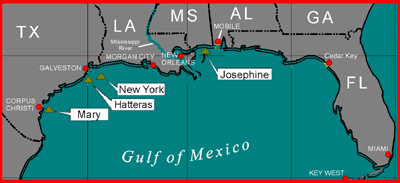
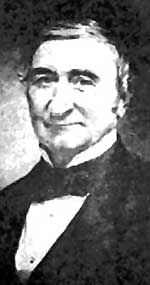 The 19th century saw many advances in ship building technology including steam power and iron hulls. Along the coastal waters of the Gulf of America some of the first merchant steamships were introduced in the 1830s by Charles Morgan, a New York businessman. Of the 117 steamships owned by Morgan or his corporate enterprises between 1833 and 1885, the wrecks of four have been discovered in the Gulf or contiguous waters. One of these, the Mary, was recorded by archaeologists off Aransas Pass, Texas, in 1995. The other three, the New York, the Josephine, and the Hatteras, were documented by MMS marine archaeologists. Taken together, these vessels represent the span of steamships employed by the Morgan Line and document the changing technology of steam navigation in the United States. Below is a summary of three of these unique vessels.
The 19th century saw many advances in ship building technology including steam power and iron hulls. Along the coastal waters of the Gulf of America some of the first merchant steamships were introduced in the 1830s by Charles Morgan, a New York businessman. Of the 117 steamships owned by Morgan or his corporate enterprises between 1833 and 1885, the wrecks of four have been discovered in the Gulf or contiguous waters. One of these, the Mary, was recorded by archaeologists off Aransas Pass, Texas, in 1995. The other three, the New York, the Josephine, and the Hatteras, were documented by MMS marine archaeologists. Taken together, these vessels represent the span of steamships employed by the Morgan Line and document the changing technology of steam navigation in the United States. Below is a summary of three of these unique vessels.
New York
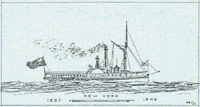 Constructed in 1837, the New York operated as a steam packet primarily along the New Orleans, LA, to Galveston, TX, route from 1839 until its demise in 1846. Unlike most of Morgan’s vessels, the New York was wooden-hulled. The vessel was registered at 365-tons, 160.5’ long by 22.5’ wide, with a 10.5’ depth of hold. The New York was chartered to transport troops to the U.S. army depot at Brazos St. Iago in south Texas on April 29, 1846, and completed several other military charters until her life ended in a hurricane on September 7, 1846. Seventeen of her passengers and crew, including five children, drowned.
Constructed in 1837, the New York operated as a steam packet primarily along the New Orleans, LA, to Galveston, TX, route from 1839 until its demise in 1846. Unlike most of Morgan’s vessels, the New York was wooden-hulled. The vessel was registered at 365-tons, 160.5’ long by 22.5’ wide, with a 10.5’ depth of hold. The New York was chartered to transport troops to the U.S. army depot at Brazos St. Iago in south Texas on April 29, 1846, and completed several other military charters until her life ended in a hurricane on September 7, 1846. Seventeen of her passengers and crew, including five children, drowned.
After a five-year search, the wreck of the New York was located by a south Louisiana oilfield worker and amateur diver. Hoping to find gold and silver, which had been reported lost on the vessel, a Louisiana salvage company was contracted to remove the sand from the hull. Fortunately, the wreck's discoverer had an appreciation of the historical importance of the wreck and resisted the recommendation of his salvage contractor to clamshell the site. Ultimately, a large area of the hull was exposed, but almost no artifacts were recovered, no doubt due to the violence of the wreck event. What few items were recovered, however, helped to secure the date of the wreck: a mortising machine patented in 1836, an 1827 King George IV gold sovereign, and two 1843 U.S. half dollars.
 In 1997, the discovery of the wreck of the New York came to the attention of BOEM marine archaeologists. During the summers of 1997 and 1998, BOEM scientific dive team made a brief reconnaissance of the site. In addition to diving, BOEM conducted a magnetometer survey of the area to determine site size and limits in order to preserve the wreck from any possible disturbance from oil and gas activities. BOEM investigation was intended to confirm the identification of the vessel and to assess the size of the wreck scatter.
In 1997, the discovery of the wreck of the New York came to the attention of BOEM marine archaeologists. During the summers of 1997 and 1998, BOEM scientific dive team made a brief reconnaissance of the site. In addition to diving, BOEM conducted a magnetometer survey of the area to determine site size and limits in order to preserve the wreck from any possible disturbance from oil and gas activities. BOEM investigation was intended to confirm the identification of the vessel and to assess the size of the wreck scatter.
BOEM is taking an active role in encouraging salvers to preserve and record the historical and archaeological data contained in wrecks on the Federal OCS. In this way, both the interests of the salvers and the American people can be protected.
Mary (41NU264)

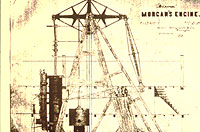
Located along the channel entrance near the town of Port Aransas, Texas, the remains of the iron-hull steamship Mary were first identified by marine archaeologists in 1989. As part of a channel improvement project, permitted by the U.S. Army Corps of Engineers, Galveston District, data recovery was conducted on the vessel in 1993. The Mary was completed in 1866 by the Harlan and Hollingsworth Company of Wilmington, Delaware, and operated along the Gulf coast from 1866 to 1876. On November 30, 1876, the Mary ran aground at Aransas Pass. Her passengers and crew survived, but the vessel and her cargo were a total loss, estimated at over $100,000. As with many of the later steamships of the Morgan Line, the Mary included a vertical walking beam engine.
Josephine (22HR843)
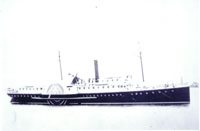 During the summers of 1997 and 1999, MMS divers conducted non-destructive surveys of the remains of a sidewheel steamship that lies about six miles off the Barrier Islands of Mississippi. Data collected from the site, and subsequent research, identified the vessel as the remains of the 19th century merchant steamship Josephine. The vessel was part of a fleet of ships owned and operated by Charles Morgan’s Louisiana and Texas Railroad and Steamship Company. Research on this vessel has led to its listing on the National Register of Historic Places, and also has resulted in the development of an instructional packet with a series of lesson plans geared toward students at the junior high level.
During the summers of 1997 and 1999, MMS divers conducted non-destructive surveys of the remains of a sidewheel steamship that lies about six miles off the Barrier Islands of Mississippi. Data collected from the site, and subsequent research, identified the vessel as the remains of the 19th century merchant steamship Josephine. The vessel was part of a fleet of ships owned and operated by Charles Morgan’s Louisiana and Texas Railroad and Steamship Company. Research on this vessel has led to its listing on the National Register of Historic Places, and also has resulted in the development of an instructional packet with a series of lesson plans geared toward students at the junior high level.
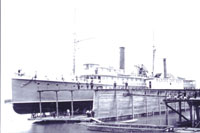 Construction of the Josephine was completed in 1867. Shortly thereafter, the vessel was brought to New Orleans and began operation along the New Orleans to Galveston route for the Morgan steamship company. The vessel made regular passage along this route twice weekly. In January, 1881 she was transferred to the New Orleans to Cuba route. On her initial return voyage from Cuba her iron-hull sprung a leak which eventually caused the ship to founder. Of the three Morgan line vessels discussed on this page, the Josephine is the most intact and provides the best opportunity for further research on these unique sidewheel steamships.
Construction of the Josephine was completed in 1867. Shortly thereafter, the vessel was brought to New Orleans and began operation along the New Orleans to Galveston route for the Morgan steamship company. The vessel made regular passage along this route twice weekly. In January, 1881 she was transferred to the New Orleans to Cuba route. On her initial return voyage from Cuba her iron-hull sprung a leak which eventually caused the ship to founder. Of the three Morgan line vessels discussed on this page, the Josephine is the most intact and provides the best opportunity for further research on these unique sidewheel steamships.
Further Reading:
Ball, Dave 2001 Historic Shipwrecks of the Gulf of Mexico: A Teacher’s Resource. U.S. Department of the Interior, Minerals Management Service, Gulf of Mexico OCS Region.
Baughman, James P. 1968. Charles Morgan and the Development of Southern Transportation. Vanderbilt University Press, Nashville.
Dayton, Fred E. and John W. Adams. 1970. Steamboat Days. Frederick A. Stokes Company, New York.
Irion, Jack B. 1989. Underwater Archaeological Investigations, Ship Island Pass, Gulfport Harbor, Mississippi, Gulf Islands National Seashore. Submitted to the U.S. Army Corps of Engineers, Mobile District. GAI Consultants, Pittsburgh.
Irion, Jack B., and Ball, David A., "The New York and the Josephine: Two Steamships of the Charles Morgan Line." The International Journal of Nautical Archaeology (2001) 30.1:48-56.
Pearson, Charles E. and Joe J. Simmons. 1995. Underwater Archaeology of the Wreck of the Steamship Mary (41NU252) and Assessment of Seven Anomalies, Corpus Christi Entrance Channel, Nueces County, Texas. Prepared for U.S. Army Corps of Engineers, Galveston District. Coastal Environments, Baton Rouge.
Ships of Exploration | 19th Century Steamships | Civil War Shipwrecks

